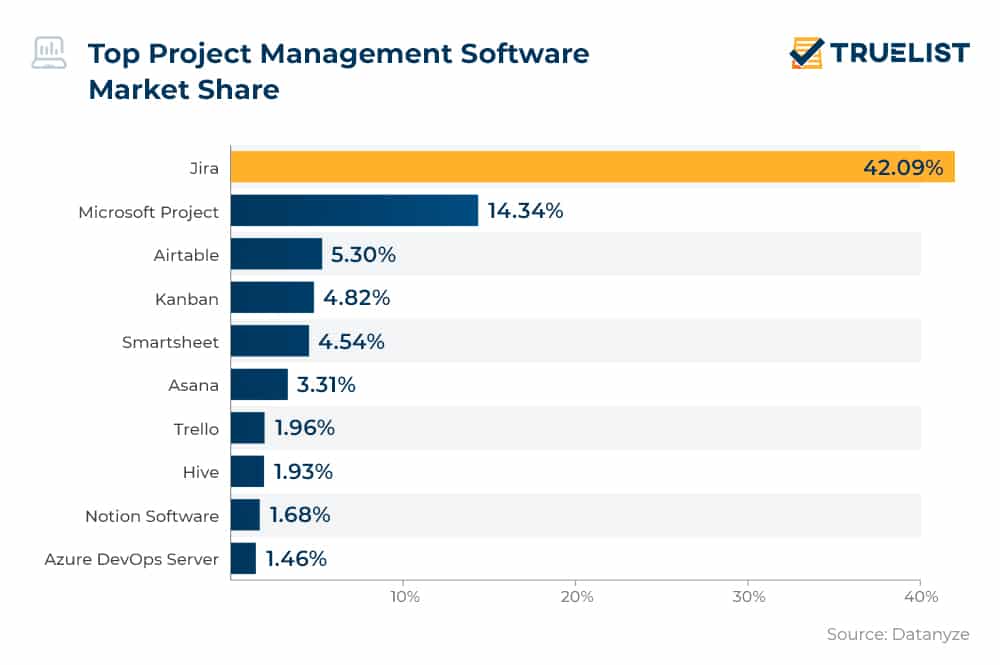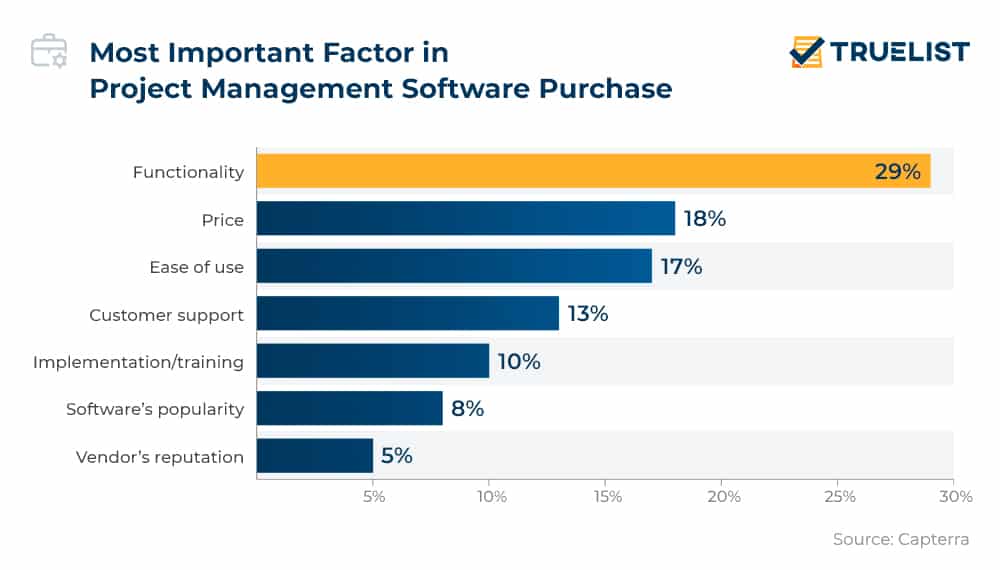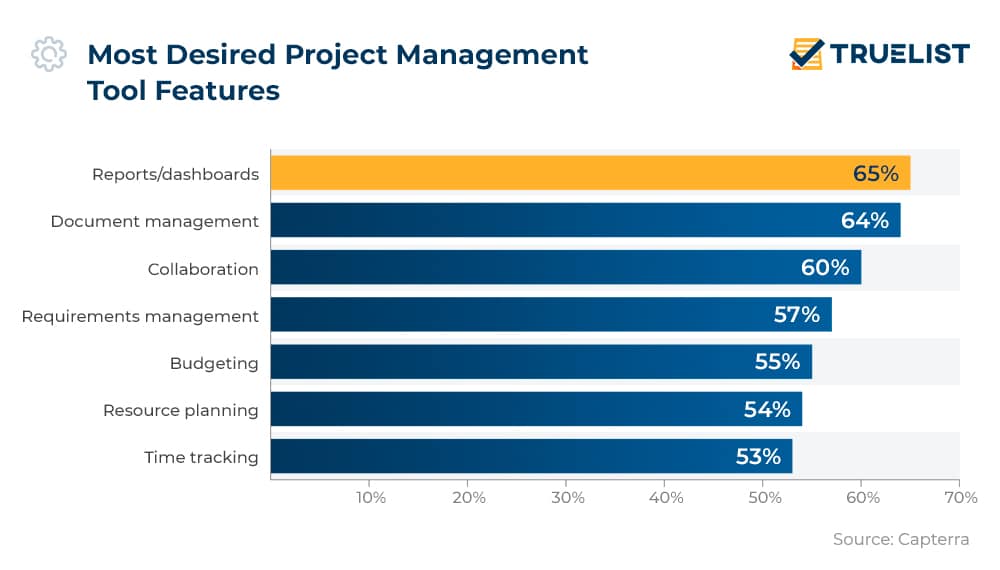Almost everyone manages a project at some point in their life, whether that’s a birthday party for their kid or a marketing campaign for their company. Regardless of your profession, project management is an essential skill highly valued in any business sector. With the project management field constantly evolving, however, it’s important to keep up with those changes. Our comprehensive list of project management statistics below will help you stay on top of things. Let’s go!
Project Management Statistics (Editor’s Choice)
- Over 50% of all projects fail. (Project Management Institute)
- Jira is the project management software industry leader with a 42.09% market share. (Datanyze)
- 39% of organizations don’t provide project management training. (TeamGantt, Research Gate)
- The project management software market is forecast to climb to $9.81 billion by 2026. (Mordor Intelligence)
- On average, project managers earn $92,274 per year. (Glassdoor, BrainStation)
- PRINCE2 is the least popular project management methodology. (Capterra)
- The use of project management software improves team communication by 52%. (Wrike)
Project Management Facts
1. 42% of survey respondents think their organizations don’t see the value of project management.
Shockingly, many organizations undervalue the importance of project management. Those that don’t use it as part of their strategy report an average of 50% of their projects failing.
(Project Management Institute)
2. The project management industry size was $4.2 billion in 2019.
The industry is bright and blooming, and it is further expected to continue growing at an annual rate of over 13.4% for the 2020-2027 period, according to project management statistics and forecasts.
(Grand View Research)
3. The project management software market is estimated to reach $9.81 billion by 2026.
It’s no surprise that the project management software industry is growing at such a fast rate. It enhances productivity, collaboration, organization, time management — the list only goes on. Some of the well-known participants include Microsoft, Asana, Trello, and Wrike, according to project management statistics.
(Mordor Intelligence)
4. A mere 23% of organizations operate without project management software.
The PM software adoption rates are relatively low even though project management software carry all the necessary features to efficiently plan a project, manage resources, and communicate with the team. Organizations state their top factors influencing the PM software purchase are functionality, price, and ease of use.
(Wellingtone, Capterra)
5. The project management software industry is projected to grow at a CAGR of 10.6% between 2021 and 2026.
Nowadays, companies are growing in size, as well as complexity, and they need someone to handle the entire portfolio of projects for them. Project management software helps teams deliver successful projects. The latest project management facts reveal that the PM software industry’s worth in 2020 was $5.37 billion.
(Mordor Intelligence)
6. Jira is the project management software market leader with a share of 42.09%.
The worldwide market size of the Project Management industry amounts to 127,924 companies. Jira is currently the most popular project management software, followed by Microsoft Project, which has a 14.34% market share. Airtable is lagging behind with a 5.13% stake.
(Datanyze)

7. Project management software saves the average manager 153 hours per year.
According to management statistics, PM software saves the average manager 10 minutes per day. These 10 minutes add up quickly, saving an impressive 153 hours/year. While many managers state that, due to high costs, investing in PM software is not worth it, the benefits will most likely outweigh the cost.
(Workzone)
8. A project management survey reveals that 89% of project managers said their organization implements hybrid project management practices.
Traditional and agile methodologies are usually considered two opposite approaches that compete with each other, but we’re here to tell you that’s not true. You can have both — the flexibility of agile and reliability of traditional. Blending these two allows you to create a customized approach for each project and improve your project success rate.
(Project Management Institute)
9. Standardized project management practices are used to some extent by 93% of organizations.
Developing project management practices is a top priority for all project managers since they are the key to better and more efficient performance. According to project management statistics, investing in these practices can save 28 times more money for companies.
(Project Management Institute)
10. Risk management practices are among the most popular practices used by project managers.
In the research conducted by the Project Management Institute, 26% of organizations say they ‘always’ use risk management practice, 34% say they use it ‘often,’ and only 3% of surveyed organizations say they ‘never’ use it.
(Project Management Institute)
11. The least popular project management methodology among project managers is PRINCE2.
According to project management statistics, integrated project management, hybrid, agile, and waterfall are the most popular methodologies used by project managers. PRINCE2 is at the other end of the spectrum, used by only 5% of organizations.
(Capterra)

12. A project manager earns $92,274 per year on average.
This stat relates only to the United States since the salary ranges depending on the location, industry, and level of education and experience. Project managers who hold the Project Management Professional certificate (PMP) earn more than their counterparts without one, according to project management stats.
(Glassdoor, BrainStation)
13. More than 65% of organizations outsourced project managers in 2018.
Rather than hiring an in-house project manager, a lot of companies are opting for outsourcing. While this method has multiple benefits, there are also many pitfalls, most notably, security issues.
(Project Management Institute)
14. Reports and dashboards are the most used project management software features.
According to a survey from Capterra, 65% of respondents most commonly use reports and dashboards. Project management stats further reveal that document management and collaboration features close the list of the top three PM software features.
(Capterra)

15. 61% of organizations provide ongoing project management training.
More and more executives have recognized the need for highly skilled project managers and are investing in training and paying for PMP certification. The benefits of project management training are numerous – from improved efficiency to better time management.
(Project Management Institute)
16. Over 50% of companies need project professionals to be certified for their role.
Project management stats show that PMP is widely recognized and the most popular certification, but there are also PRINCE2, SAFe, CAPM, and ITL. Each of these certificates differs depending on the industry, and some jobs don’t even require that you obtain a certificate. Whether the company requires a certificate or not, having one is a must if you want to advance your career.
(Project Management Institute)
Project Failure Statistics
17. 39% of projects fail due to poor planning.
Lack of planning is the reason why 39% of projects fail. Poor project planning can be disastrous, whereas the consequences are usually high costs and time overruns.
(TeamGantt, Research Gate)
18. Almost 20% of IT projects can fail so badly that they can become a threat to a company’s existence.
66% of IT projects fail partially or completely. You’re probably wondering why technology projects fail so often and at such an astonishingly high rate — the answer is bad project management. Lack of proper planning, poor communication, and poorly defined goals all contribute to the failure of projects.
(McKinsey, AtlasCode)
19. IT project failure statistics indicate that the percentage of projects that fail ranges between 5% and 15%.
There is a wealth of reasons why IT projects fail. Project management, business, people, methodology, and technicality are the top five areas influencing project failure or success, with project management being the most important. The importance of project management has increased due to many organizations realizing the value it brings to their business.
(Gallup)
20. An average budget overrun for IT projects is 27%.
Poor project management comes with a price tag, especially in the information technology sector. These overruns also affect the national economies. Project management failure statistics show that the failure of IT programs costs the global economy a whopping $6.2 trillion a year.
(Gallup, ZDNet)
21. Project management software improves team communication by 52%.
As much as 30% of projects fail due to poor communication. Although the causes of project failure are wide and varied, ineffective communication can be almost eliminated by using project management software. It’s important to note that 66% of organizations use project management software to communicate with clients.
(Wrike)
Project Management Success Statistics
22. The use of BPM software can boost the success rate of your projects by 70%.
Research giant Gartner looked at the results of 150 BPM implementations and found that 95% of projects undertaken were successful. What’s even better is that BPM software can eliminate the worst nightmare of every project manager — bottlenecks.
(Process Street)
23. 89% of high-performing companies tend to complete projects successfully.
Contrary to high-performing companies, low-performing companies only complete 36% of their projects successfully. Additionally, nearly 60% of companies report that the key to project success is defined processes and practices, according to project management success statistics.
(Project Management Institute, Wellingtone)
24. According to a PwC survey, a whopping 97% of companies think that project management is essential to company growth and organizational progress.
The majority of projects are complex and require careful planning, organizing, and monitoring. That’s where the project management comes in — it ensures that organizations gain control to ultimately deliver stellar results, all within the project’s constraints.
(Capterra)
Project Management FAQ
How does project management improve the success rate of IT projects?
IT and software project failure statistics show that the most common reason for failure in the information technology industry is poor planning and communication. Project management is the key to good planning, great communication, staying on budget, clear objectives, and increased employee productivity. All these factors contribute to the IT projects success rate.
(Fresh Service)
What is the percentage of projects that fail?
About 70% of all projects fail, according to project management failure statistics.
(Sandbox Model)
How many projects can a project manager manage?
That number depends on multiple factors, with duration and scope being the most relevant. Time management statistics even suggest that an individual should not work on more than two or three projects simultaneously.
(RGPM)
What is the most common cause for the failure of development projects?
The most common cause of failure, apart from bad project management, is a change in organizational priorities Lack of proper planning, poor communication, poorly defined goals – all of these things contribute to the failure of projects.
(Kissflow)
What is the average age of a project manager?
Project management fun facts in a survey by the Australian Institute of Project Management reveal that the average age of project managers is 46 years.
(Zippia)
What are the five stages of project management?
The five stages of the project life cycle are conception and initiation, planning, execution, performance/monitoring, and project close. However, stakeholders can determine the number of stages at their own preference, depending on the type of project management, the participating team, and the resources.
(NI Business Info)
What percentage of a project should be project management?
Project management statistics indicate that this depends on the size of the project. A short scope document, a few cost accounts, and a milestone schedule may be included in small projects. Large projects, meanwhile, might consist of a detailed scope document, a work breakdown structure, an elaborate and integrated project schedule, numerous cost accounts, detailed progress reports, and so on.
(Project Management Institute)
Sources: Project Management Institute, Grand View Research, Mordor Intelligence, Wellingtone, Capterra, Datanyze, Workzone, Project Management Institute, Project Management Institute, Glassdoor, BrainStation, Project Management Institute, TeamGantt, Research Gate, McKinsey, AtlasCode, Gallup, ZDNet, Wrike, Process Street, Project Management Institute, Capterra, Fresh Service, Sandbox Mode, RGPM, Kissflow, Zippia, NI Business Info, Project Management Institute

